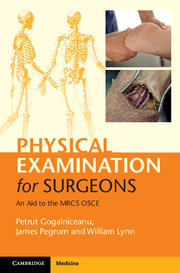Book contents
- Frontmatter
- Dedication
- Contents
- List of contributors
- Introduction
- Acknowledgments
- List of abbreviations
- Section 1 Principles of surgery
- Section 2 General surgery
- Section 3 Breast surgery
- Section 4 Pelvis and perineum
- Section 5 Orthopaedic surgery
- Section 6 Vascular surgery
- Section 7 Heart and thorax
- Section 8 Head and neck surgery
- Section 9 Neurosurgery
- Section 10 Plastic surgery
- Section 11 Surgical radiology
- 44 Principles of plain film
- 45 Chest x-ray
- 46 Abdominal x-ray
- 47 Mammogram
- 48 Facial x-ray
- 49 Cervical spine x-ray
- 50 Shoulder x-ray
- 51 Elbow x-ray
- 52 Wrist and distal forearm x-ray
- 53 Pelvis and hip x-ray
- 54 Knee x-ray
- 55 Foot and ankle x-ray
- 56 Principles of CT
- 57 Head CT
- 58 Chest CT
- 59 Abdomen CT
- 60 Aorta CT
- 61 Kidneys, ureter and bladder CT
- 62 Lower limb CT angiogram
- Section 12 Airway, trauma and critical care
- Index
49 - Cervical spine x-ray
from Section 11 - Surgical radiology
Published online by Cambridge University Press: 05 July 2015
- Frontmatter
- Dedication
- Contents
- List of contributors
- Introduction
- Acknowledgments
- List of abbreviations
- Section 1 Principles of surgery
- Section 2 General surgery
- Section 3 Breast surgery
- Section 4 Pelvis and perineum
- Section 5 Orthopaedic surgery
- Section 6 Vascular surgery
- Section 7 Heart and thorax
- Section 8 Head and neck surgery
- Section 9 Neurosurgery
- Section 10 Plastic surgery
- Section 11 Surgical radiology
- 44 Principles of plain film
- 45 Chest x-ray
- 46 Abdominal x-ray
- 47 Mammogram
- 48 Facial x-ray
- 49 Cervical spine x-ray
- 50 Shoulder x-ray
- 51 Elbow x-ray
- 52 Wrist and distal forearm x-ray
- 53 Pelvis and hip x-ray
- 54 Knee x-ray
- 55 Foot and ankle x-ray
- 56 Principles of CT
- 57 Head CT
- 58 Chest CT
- 59 Abdomen CT
- 60 Aorta CT
- 61 Kidneys, ureter and bladder CT
- 62 Lower limb CT angiogram
- Section 12 Airway, trauma and critical care
- Index
Summary
Introduction
‘This is an x-ray of the cervical spine in AP/lateral/open-mouth view. It is (is not) an adequate film because C1 to C7/T1 junction have (have not) been included.’
Summary
A Address
A Adequate
A Alignment
B Bone
C Cartilage
E Everything else
Checklist
Address
• Name and date of birth
Adequate (views)
• Non-trauma: AP and lateral
• Trauma:
1. AP
2. lateral, C1 to C7/T1
3. peg view/open mouth
Alignment
• Lateral view:
• anterior longitudinal line
• posterior longitudinal line
• spinolaminar line
• spinous process (interspinous) line
• AP view:
• transverse spinous processes line up
• posterior spinous processes align themselves when seen ‘end on’
• Peg view:
• equal spaces on either side of C1 peg to C2 body
• lateral margins of C1–C2 align; if not aligned, suggestive of C1 blow-out (Jefferson) fracture
Bone
• Lateral view:
• all vertebral body heights must be the same
• anterior and posterior aspects of vertebral bodies should be concave
• AP view:
• spinous processes lie in straight line and are equidistant from each other
• the lateral edges of the vertebral bodies should all be equally aligned
• all vertebral bodies have two pedicles (owl eyes) – if not this suggests lytic destruction of pedicle (spinal tumour – usually metastatic)
• an increase in the interpedicular distance compared to the vertebral levels below is indicative of a burst type fracture
• Peg view:
• C2 vertebra odontoid process (peg) intact
• lateral margins of C1 and C2 align; failure of alignment suggests blow-out fracture of C1 (Jefferson's fracture)
Cartilage and ligaments
• Increased prevertebral soft tissue thickness is abnormal and can be a sign of a haematoma and occult fracture. Abnormal thickness is defined either in relation to the size of the adjacent vertebra or in millimetres.
- Type
- Chapter
- Information
- Physical Examination for SurgeonsAn Aid to the MRCS OSCE, pp. 414 - 417Publisher: Cambridge University PressPrint publication year: 2015



